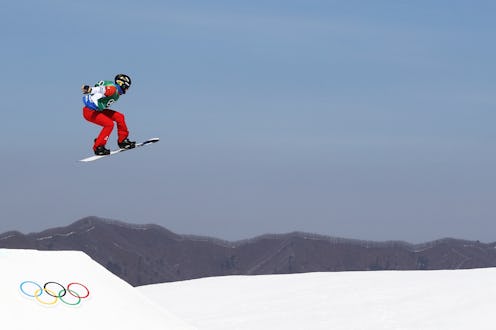
Snowboarding is always one of the most popular events at the Winter Olympic Games due to the extreme tricks and jumps that only the best of the best can successfully pull off. This year, it's being taken to an even more intense level with the new big air snowboarding event. Every sport in the Olympics requires serious skill, but this one is especially intense, and will leave viewers wondering how high snowboarders jump during it.
In big air snowboarding, the competitors board off of a steep ramp that resembles a ski jump, and then they do one big trick while in the air. It's been considered an extreme sport for a while, but this is its first appearance at the Olympics. This event has two qualifying runs and three final runs where competitors can repeat the same tricks or do different ones. The single best run counts for qualifying and the finals is a two-out-of-three format. The top two scores are combined to find a winner, and twelve riders will make it to finals.
Standing at 49 meters (about 160 feet) tall, the snow ramp at PyeongChang is the biggest in the world. At its steepest point, its slope reaches 40 degrees. If you thought the snowboarders were doing huge jumps during the slopeside and half-pipe events, this one will blow you away. The snowboarders will be higher than in other events, and they'll be in the air for longer. The size of the ramp means that they'll be flying up to 50 mph, which leads to some serious air.
According to Scientific American, snowboarders have to use physics to their advantage to do big air snowboarding successfully, without getting hurt: "To excel in this competition, snowboarders will have to control their nerves and adrenaline while intuitively mastering the physics of angular momentum, energy conservation and snow thermodynamics, along with projectile motion (with themselves as the projectiles). Then there is the landing: A mistimed pop off the jump or one trick too many could lead to a broken wrist, ankle, knee or worse on the quick return to Earth."
So jumping from that high and fast has to equal a painful landing, right? According to Snowmie, not if you land correctly. There's a "sweet spot" at the landing, which means that there's almost no impact on your body, regardless of how high you're falling from. The sweet spot is the "sloped area between the knuckle of the jump and the flat area at the bottom of the landing."
There aren't numbers on exactly how high snowboarders are jumping during big air. It's important to point out that that number will always vary depending on the athlete riding, the jumps they're doing, and the speed they're going. Consider the fact that a half-pipe is typically about 22 feet, and riders are flying high above that - so, if they're flying off of a 160 feet ramp, they're likely going higher than half-pipe riders are. Snowmie says that "A 50 foot 'big air' jump may send the rider upwards 20 feet, while a normal 50 foot jump may only send the rider up 10 feet." So, again, it really depends on the rider.
That said, the big air competition is sure to be one you won't want to miss. On Team USA, look out for Ryan Stassel, the reigning slopestyle world champion who is currently number 2 in the international big air standings. You should also keep an eye on Colorado's Chris Corning, and Red Gerard, who, at 15-years-old, has already won an Olympic gold medal. As for the female snowboarders, Vermont's Ty Walker is one to watch, as she won the first women's big air world cup in 2014. It should definitely be a good show!